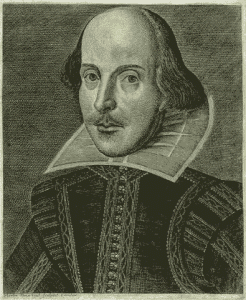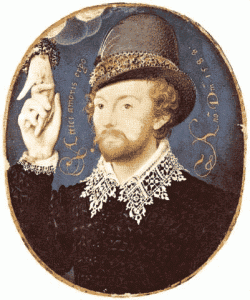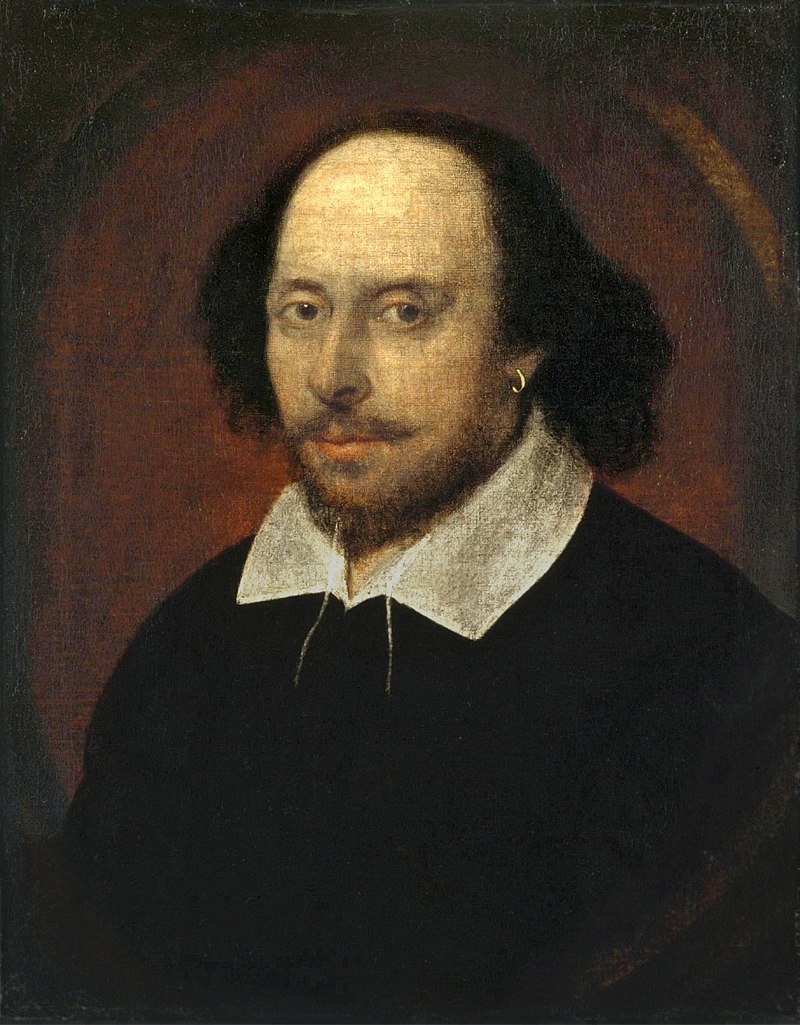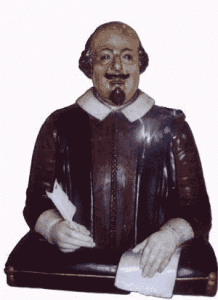This page runs through the various William Shakespeare images that exist. Sadly there’s no William Shakespeare photo (as cameras were not around in the Elizabethan era!), but there are a number of Shakespeare portraits, paintings, engravings, and sculptures.
As with many questions about Shakespeare dealing with his life and identity, determining what William Shakespeare really looked like is a tricky area, full of supposition, conjecture, and guesswork. Of the images of Shakespeare that have been created over the years, each has its champions who insist that a particular Shakespeare image is the true representation of the man.
Below are what are regarded as the most important William Shakespeare images, along with a brief overview of each, and our take on how likely it is to be a lifelike Shakespeare image.
NoSweatShakespeare Logo
Whenever anyone wants to create an instant recognition impression of Shakespeare they present this kind of shorthand image – a man with a dome-like high forehead, a beard and moustache, and shoulder-length hair. As soon as you see it you think ‘Shakespeare.’ This logo – and the many similar Shakespeare images – are inspired by the Droeshout engraving.
Likelihood of being a lifelike image of Shakespeare: 6/10

NoSweatShakespeare logo
The Droeshout Engraving
The Droeshout engraving is a strong contender for the distinction of being a good likeness of Shakespeare, although it is not lifelike. The English engraver, Martin Droeshout, created it for the First Folio (first edition) of Shakespeare’s published works. Droeshout was 15 when Shakespeare died and 22 when he did the engraving. It is unlikely that he ever saw Shakespeare, but he is thought to have worked from an authentic Shakespeare portrait which either hasn’t survived or hasn’t yet been identified. Scholars are increasingly excited that a consensus seems to be growing that the Cobbe portrait is that painting.

The Droeshout engraving
Likelihood of being a lifelike image of Shakespeare: 7/10
The Hilliard Miniature
Titled ‘An unknown Man’, the Hilliard Minature is very pretty, but there is not a great deal of credibility in the claim that it is a portrait of Shakespeare. Apart from everything else, it is nothing like the more credible images and is an expensive painting by a society artist. It is also clearly a portrait of a young aristocrat, which Shakespeare was not. We feel it’s very unlikely this miniature is even intended to be a portrait of Shakespeare.
Likelihood of being a lifelike image of Shakespeare: 3/10

The Hilliard miniature
The Sanders Portrait
The Sanders Portrait was discovered in an attic in a house in Canada in 2002. It created a great deal of interest, with experts taking sides at numerous conferences about it. It’s a nice idea that this is an authentic picture of the young Shakespeare, but there are a number of problems with the portrait – not least that it was painted when Shakespeare was 39 years old, but it is a painting of a much younger man.
Likelihood of being a lifelike image of Shakespeare: 4/10

The Sanders portrait of William Shakespeare
The Chandos Portrait
The Chandos Portrait is lifelike and was thought to have been painted by a member of Shakespeare’s acting company, Richard Burbage. Unfortunately, most experts agree that it is unlikely that it is a portrait of Shakespeare. It does resemble the Droeshout engraving, though.
Likelihood of being a lifelike image of Shakespeare: 4/10

Chandos portrait of William Shakespeare
The Holy Trinity Bust
The Holy Trinity Bust was commissioned after William Shakespeare’s death by his son-in-law and placed above his grave in the Holy Trinity Church. His widow was still alive then, and we can’t imagine that they would have placed a false image of him over his grave! There is general agreement that this is the likeness of Shakespeare, looking rather old and bloated, but that’s life: we can’t expect our hero to fit the fantasies we may have about him.

The Holy Trinity Bust of Shakespeare
Likelihood of being a lifelike image of Shakespeare: 8/10
The Cobbe Portrait
The Cobbe portrait is a panel painting displayed at Hatchlands Park in Surrey. Discovered in 2006, researchers at the Shakespeare Birthplace Trust claimed in 2009 that it is a painting of Shakespeare, painted from life. Their evidence includes the fact that the painting came to the Cobbe family via Shakespeare’s patron it was the Earl of Southampton’s great-granddaughter who inherited it.
Likelihood of being a lifelike image of Shakespeare: 7/10

The Cobbe portrait
Which of these images of Shakespeare gives the best representation of how he looked in real life is likely one of those things about the Bard that will never be resolved. Though there’s evidence the Cobbe portrait may have been painted from life we should stick with the Droeshout engraving for a general idea of Shakespeare’s appearance. To see it in the flesh go to Stratford, and visit the Holy Trinity Church for a true impression of what Shakespeare looked like shortly before his death.
What Would Shakespeare Look Like If He Lived Today?
An historian, working with a team of digital artists, has spent three months updating a series of classic portraits to reflect how historical figures might look today. Shakespeare is one of the subjects, using the Cobbe portrait of 1610, in which Shakespeare, is splendidly dressed in aristocratic clothes, like the wealthy man he was by 1610. They have left him pretty much as he is in the portrait, but changed his hairstyle and dressed him in a striped tee-shirt and a casual but traditional style of jacket. In that portrait, he comes across as lean and hungry, although other portraits of Shakespeare show him to be more full-faced.

How Shakespeare looks – then and now?
It’s an interesting idea and it’s set me on my own course, thinking about what Shakespeare might have looked like today. I like the Chandos portrait, in which Shakespeare has quite wild hair and facial growth. He’s wearing an earring, too, a feature of the portrait that I’ve always liked. I prefer the earring to the crucifix that the digital artists have hung around his neck. In the Chandos portrait he’s wearing very plain clothes – a black suit and a white collar, like a Puritan.
We have to consider what he might have been like if he were living today. We must also assume that he would be a great writer whose work will be read and studied for the next half millennia. Much has changed in the last half millennia and the only thing that hasn’t is human nature. Shakespeare lived before the Industrial Revolution, so even the most primitive of steam-driven machines couldn’t have been imagined by him, not to mention the wonders of the digital age.
Given all that, though, what would he be like today? Alright then, he’s a writer – a successful one, making a lot of money. He was also a theatre director so let’s transpose him to a man who makes a lot of money writing and directing scripts. That would make him a Hollywood film man. Given his talent, he would also be going around the circuit picking up awards for his films. I place him as a cross between Stephen Spielberg and Quentin Tarantino.
Both those movie men are more hard-working filmmakers than celebrities. Whenever we see them they appear as men who aren’t very concerned about their appearance and the image they create. They’re fanatical about film making. That’s Shakespeare, too – a very hard-working playmaker. Spielberg and Tarantino are both rich men, but like Shakespeare, they don’t take the money and run, they keep on working. As Shakespeare did, even after his retirement from the theatre.
I think the Chandos portrait shows Shakespeare more or less as he would be today. The unruly hair and beard indicate a man more interested in working than in creating an image. The simple clothes show a lack of interest in social graces. I’m going to keep the earring, which is every bit as modern today as it was in his time. It suggests a man who rejects conformity.
This is a spurious exercise, however, because Shakespeare was a product of the Elizabethan age, a very different age from ours and there’s no way one can make comparisons between people living in such different cultural contexts. To drape him in modern clothes and give him a contemporary hairstyle the digital team has done is the best anyone could do.
If you have any ideas about what Shakespeare might have been like if he’d been born in our time let us know in the comments below!




Normal People:
Mum I’m Hungry
Shakespeare:
Let it be know to thy birth giver that thy stomach consists of nothingness
According to R. F. Whalen, the original bust of Stratford depicted, not William Shakspeare, but his father John Shakspeare, the wool-dealer.
The Chandos painting sitter remains unknown:
https://issuu.com/doucetjp/docs/chandos_paper_07_2021
The real portraits of The Bard:
https://issuu.com/home/published/old2_vertue_paper_11_2021
The good web site for the real portraits of The Bard is:
https://issuu.com/doucetjp/docs/old2_vertue_paper_11_2021
For the Sanders painting the likelihood of being a lifelike image of Shakespeare is 10/10
https://www.youtube.com/watch?v=eR3rYY0UH0M